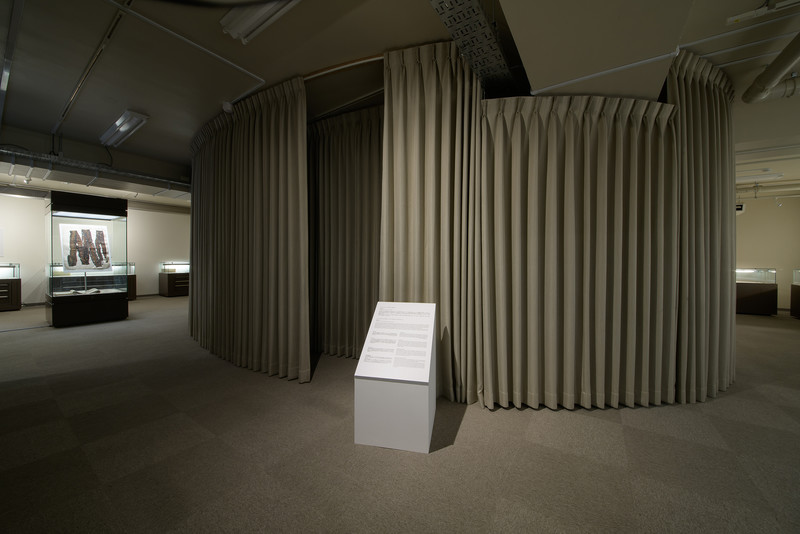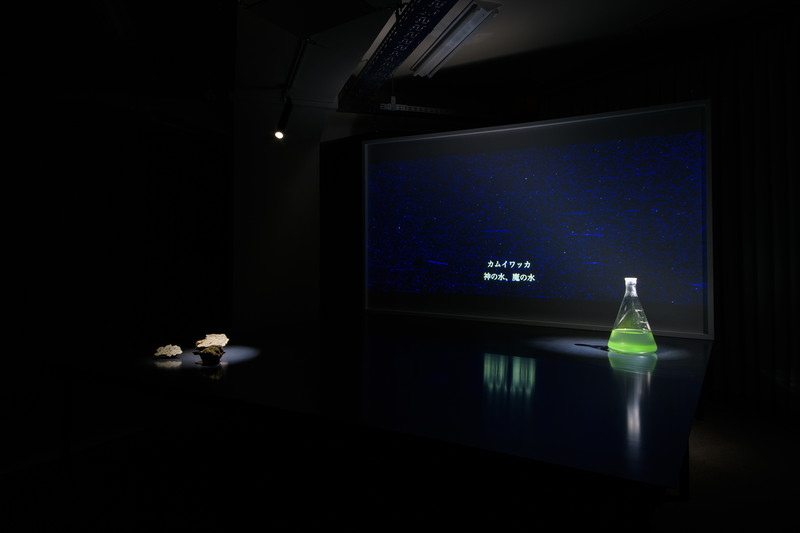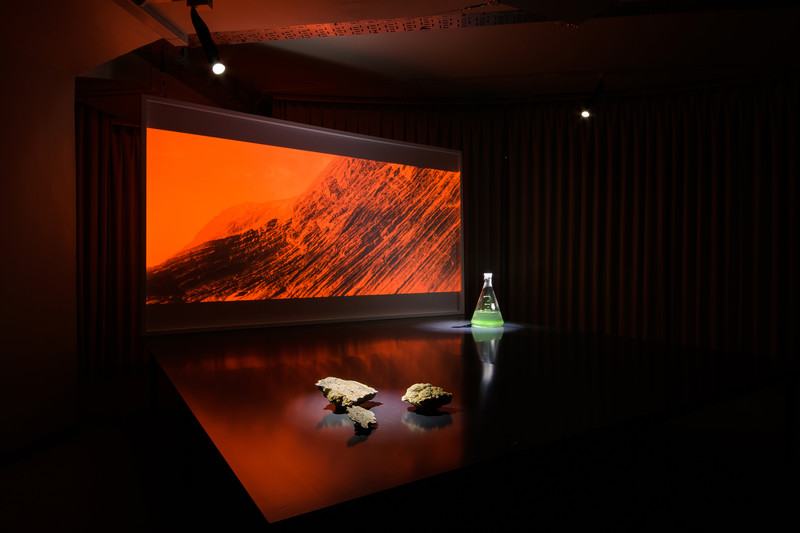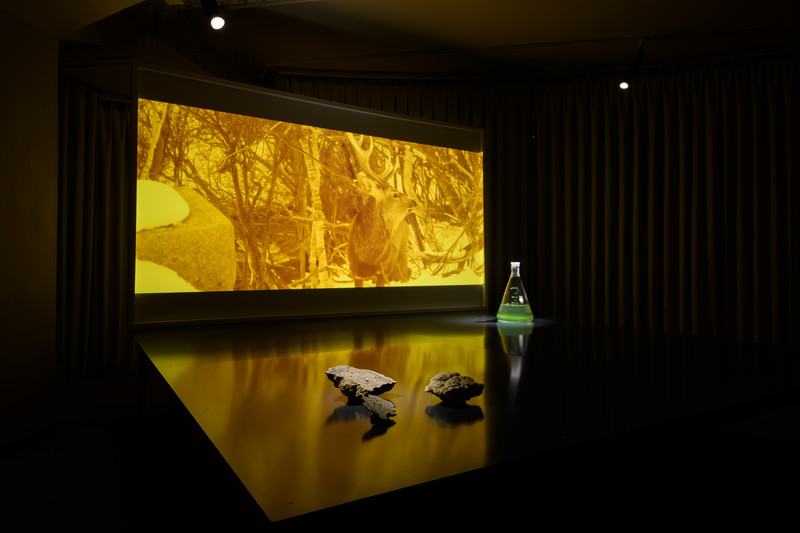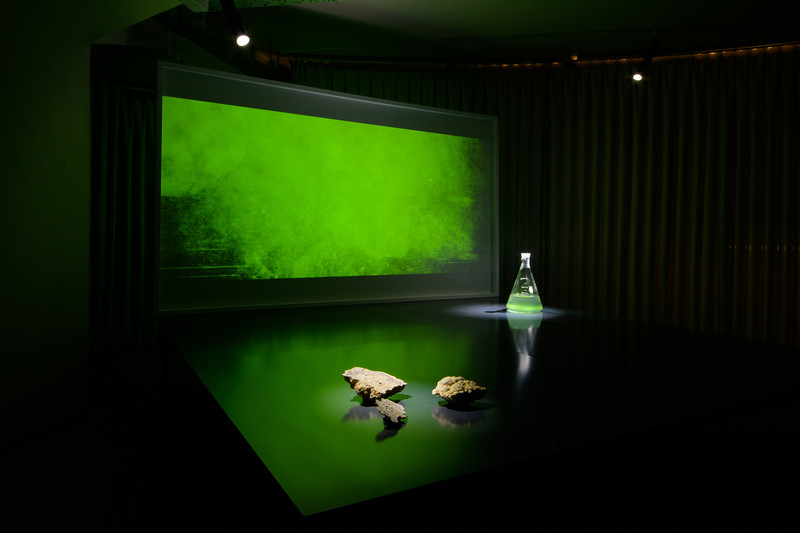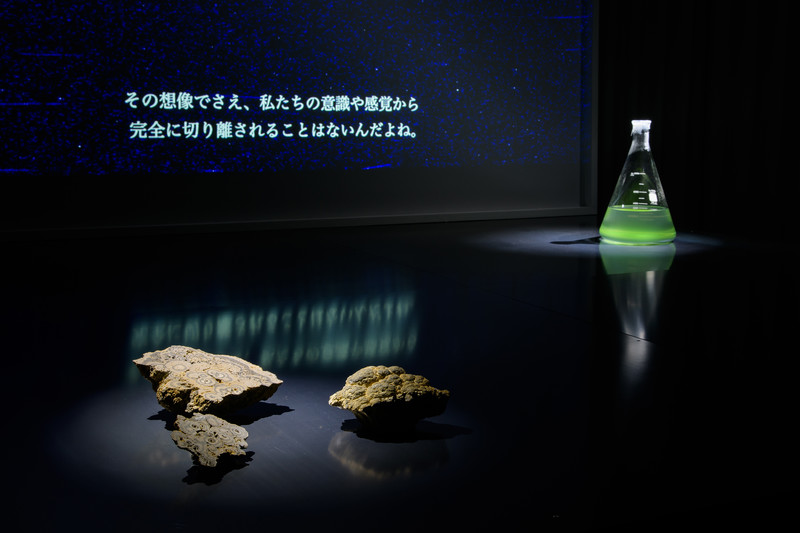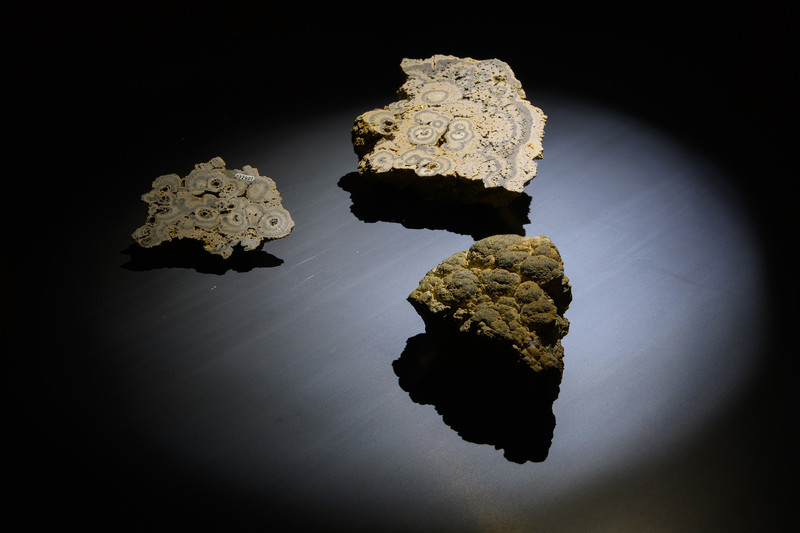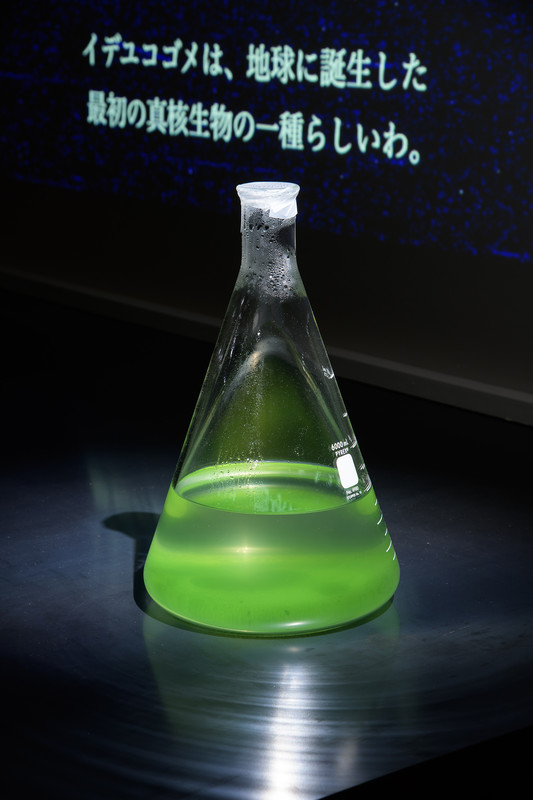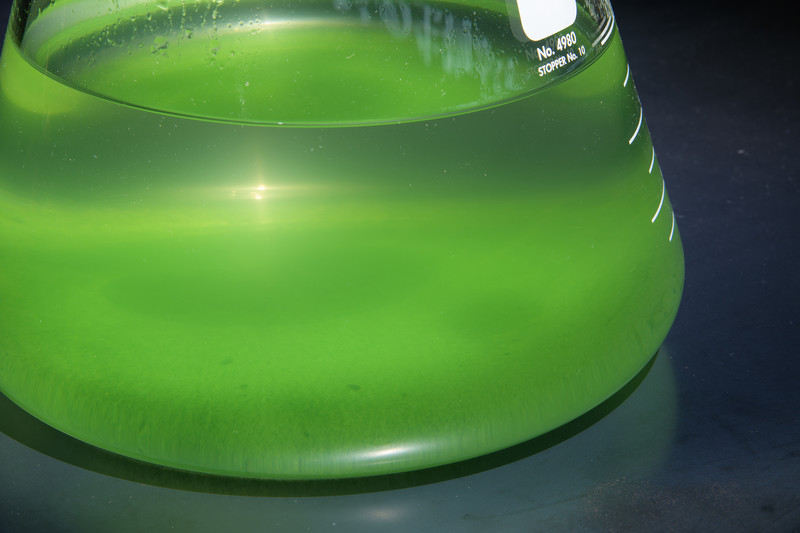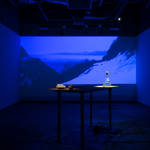カムイワッカへ、そして私たちの始まりへ @ 北海道大学総合博物館 / To the Kamuy-Wakka, To the Spring of Eukaryotes @ The Hokkaido University Museum
カムイワッカへ、そして私たちの始まりへ
2021年
インスタレーション
映像(23分)、藻(イデユコゴメ)、化石(ストロマトライト)、鉄板
長坂は2018年に初めて道東を訪問した際に、知床半島にあるというカムイワッカ湯の滝の存在を知った。この土地に暮らしてきたアイヌの人々が、高温、強酸性で生物が棲んでいないと言われていた滝にかつてつけた「カムイワッカ(神の水、魔の水)」という名前に惹かれてリサーチを進めるなかで、その滝にはイデユコゴメという原始の地球環境下でも存在していた藻が棲息していることを知った。そこで長坂は、人間を含めた動植物の先祖でもあるイデユコゴメを見るために、そして現在の環境に変容する以前の原始の地球の風景に出会うために、雪に閉ざされた冬の知床半島に分け入り、歩いてカムイワッカ湯の滝を目指すことにした。
その体験をもとにして制作されたこの作品は、カムイワッカ湯の滝への身体的な旅と太古の地球への空想的な時間旅行を物語ることを通して、私たち人間が持っている根源的な未知への好奇心と、他者と共有したいという願望について一石を投じている。
ストロマトライト
ストロマトライトは、シアノバクテリア類などの光合成に伴い、石灰物が沈殿あるいは沈着することによって形成された石灰岩生物構造の総称である。西オーストラリアやバハマ島などでは現在でも形成されていることが知られている。最も古いものは38億年前とされており、30億年前以降の先カンブリア代に大量に形成され、同時に光合成に伴って大量の酸素が海洋や大気中に供給された。その結果、空気中の酸素は22 億年前に急増し、この破局的な大気汚染が引きがねとなって、それまで支配的だった嫌気性生物が縮退し、好気性生物が大発展の機会を得た。
イデユコゴメ
世界各地の強酸性温泉に生息し、中性pHや常温では増殖することができない、好酸性・好熱性の単細胞藻類。紅藻の現生の系統では、最も初期に分岐した原始的なグループであると考えられており、ある研究によれば、イデユコゴメの系統がそれ以外の紅藻から分岐したのは約14億年前と推定されている。本種は光合成色素として、他の典型的な紅藻類が持つフィコエリスリンを持たないため、クロロフィルやフィコシアニンに由来する青緑色をしている。
縞状鉄鋼層(鉄)
全世界で年間約6億トン生産されている鉄の原料の8割以上が縞状鉄鉱層である。縞状鉄鉱層は地球の歴史を考える上でも重要な試料となっている。それは、初期の地球の環境を知るための有力な手がかりを与えてくれるからだ。最も古い縞状鉄鉱層は、グリーンランド西海岸のイスアで、およそ38 億年前とされている。35 億年前から18億年前にかけて形成されているが、もっとも大量に形成されたのは25 億年前あたりで、ほぼストロマトライトの形成年代と重なっている。シアノバクテリアの繁栄に伴う酸素の供給によって、海水中の鉄イオンが酸化され、水酸化鉄として海底に沈殿し、 後の変成作用で磁鉄鉱や赤鉄鉱、菱鉄鉱等に変質したと考えられている。
/////
To the Kamuy-Wakka, To the Spring of Eukaryotes
2021
Installation
Video (23’), Alga (Cyanidium caldarium), Fossil (Stromatolite), Iron Plate
On her first visit to eastern Hokkaido in 2018, Nagasaka came to know about Kamuy-wakka Hot Waterfall in the Shiretoko Peninsula. She was intrigued by the story behind the name: Ainu people who lived in the area thought this highly-acidic, lifeless hot spring water was poisonous and not for them to drink, thus, they called it kamuy-wakka, meaning both; god water and evil water. As she started researching the waterfall, she learned that a species of algae actually lives in the waterfall and it is an old primitive species that has been living on Earth for billions of years. With the desire to see the rare alga living in the extreme condition and to search for scenery that existed on the ancient Earth before the environment drastically changed, she decided to head to the waterfall in the snowy, human-deserted Shiretoko Peninsula by foot.
Combining visual-audio storytelling, objects, and a living organism, the work invites the viewers to take a journey to the waterfall and to time travel to the ancient Earth. It also prompts them to ponder the traits we humans fundamentally have: curiosity towards unseen things and our desire to communicate our thoughts and feelings with others.
Stromatolite
Stromatolite is the collective term used for limestone formed b y the sedimentation or deposition of calcareous substances associated with photosynthesis by cyanobacteria. They are still formed at present in western Australia, the Bahamas, etc. The oldest of them is presumed to be from 3.5 billion years ago. They were formed abundantly in the Precambrian age from 3 billion years ago. At the same time a large quantity of oxygen was released into the ocean and the atmosphere along with photosynthesis. As a result, oxygen in the air increased rapidly 2.2 billion years ago. This catastrophic air pollution triggered the withdrawal of anaerobes, which had been dominant, and gave aerobes an opportunity to flourish.
Cyanidium caladium
Cyanidium caldarium is a species of acidophilus, thermophilic unicellular algae that live in strong acidic hot springs all over the world. They cannot proliferate in regular temperature or in a neutral pH. Among the existing lineages of red algae, they are consider ed as the primitive group that branched out at the very beginning. According to some research, it is estimated that they branched out from the rest of red algae about 1.4 billion years ago. This species lacks phycoerythrin, which other typical red algae have as one of their photosynthetic pigments, thus, they have a blue-green color derived from chlorophyll and phycocyanin.
Banded Iron Formation (Iron)
More than 80% of iron produced each year (about 600 million ton s per year) comes from banded iron formations. Banded iron formations are also important samples t o ascertain the history of Earth because they provide important clues to elucidate the Earth’s early environment.
The oldest banded iron formation was discovered in Isua on the west coast of Greenland, which is regarded as first forming about 3.8 billion years ago. It mainly formed from 3.5 billion to 1.8 billion years ago, and most abundantly at around 2.5 billion years ago, which approximately overlaps the age of the formation of stromatolites. It is considered that the oxygen supply that occurred with the prosperity of cyanobacteria oxidized iron ions in seawater, later precipitating on the bottom of the sea as iron hydroxide, and subsequently changing into magnetite, hematite, siderite, etc. through metamorphism.
